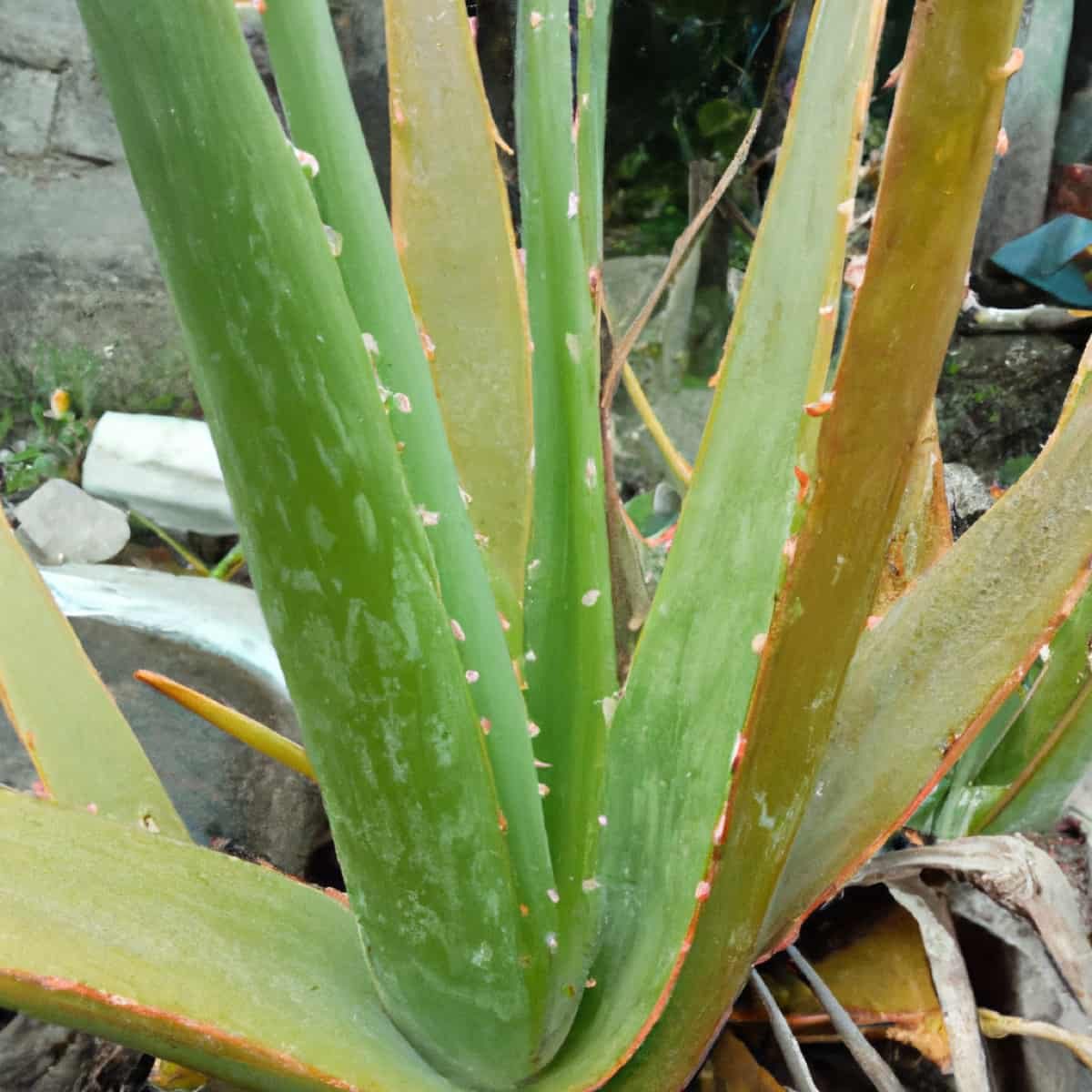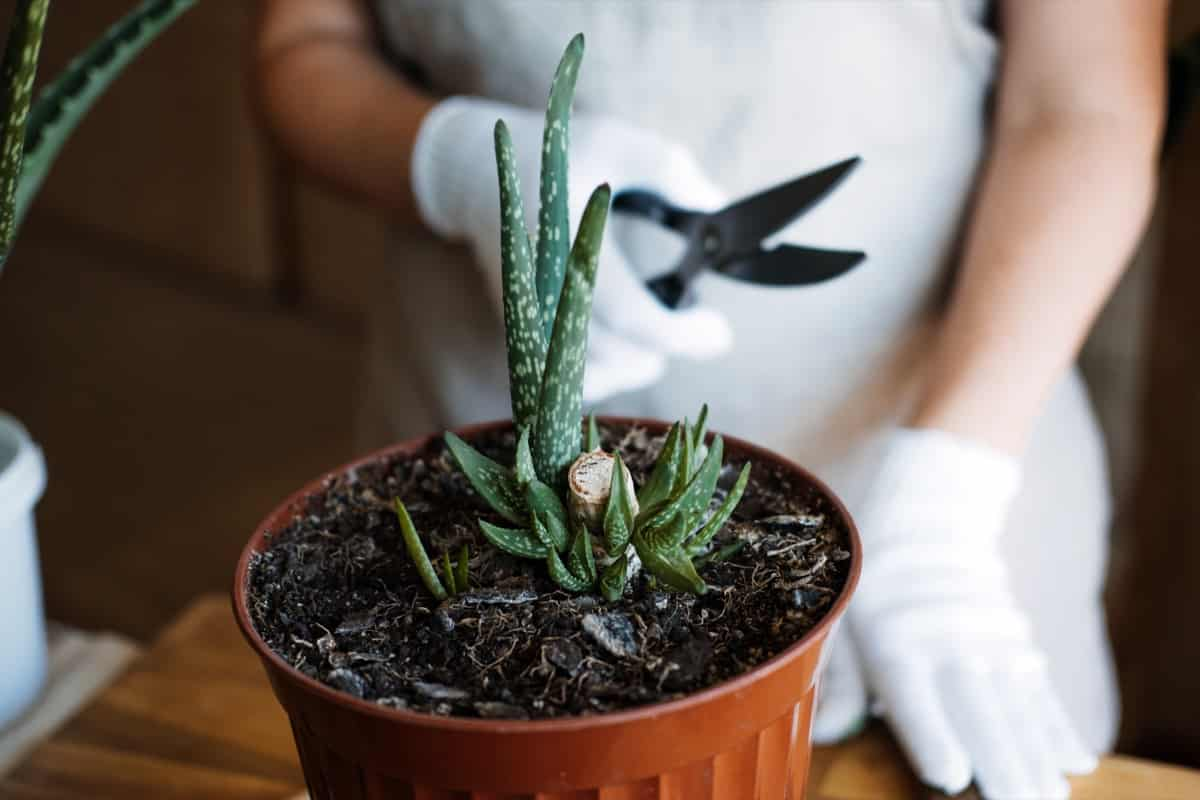Succulents such as Aloe Vera are extremely popular indoor plants. Aside from their attractive appearance, their juice can also treat and relieve pain caused by burns, cuts, and bug bites in any indoor space. Despite Aloe Vera’s ease of growing, some indoor gardeners report its leaves turning brown and mushy. It is time to take action if your Aloe Vera plant displays discolored and droopy leaves with brown spots.

10 Reasons Why Your Aloe Vera is Turning Brown and Mushy
Overwatering and Mushy Brown Aloe Vera Leaves: Preventing Root Rot
The most common reason for browning Aloe Vera leaves is overwatering. Due to its succulent nature, this indoor plant prefers dry soil. When the leaves turn brown or yellow instead of their natural green color, the plant has probably been overwatered, or the soil is too moist.
- Wait until the soil feels dry between waterings to prevent overwatering your Aloe Vera plant. It is ideal for your Aloe plant to completely dry 75% of its soil before you water it again.
- Ensure the pot you choose has a drainage hole so excess water can drain through the bottom.
Sunburn and Browning of Aloe Vera Leaves: Finding the Right Light Conditions
Overexposure to direct sunlight is another cause of browned Aloe Vera leaves. Although their rugged, desert-like appearance might make you think they thrive in sunny conditions, too much light can burn their leaves. In order to prevent your Aloe Vera leaves from burning and turning brown, ensure they receive plenty of indirect sunlight. Consider placing your plant a few feet away from the window rather than on the windowsill. Rather than being directly in the sun, the plant will thrive in a well-lit room where it receives plenty of natural light.
Fungal Infections and Mushy Brown Aloe Vera Leaves: Treatment and Prevention
Rust Spots on Aloe Leaves
A fungal infection, rust spots infest aloe vera leaves when moist and warm. A low level of light could also be responsible. There are usually small red or brown spots on the underside of leaves that look like rust. They can merge and form larger, scruffy bumps as a result.
Treatment and Prevention
- Rust spots, for the most part, are not dangerous. They can, however, be unsightly.
- Use a dishwasher spray to soak the leaves, then hose them down to remove the rust.
- Make sure your aloe is as dry as possible. Rather than overhead watering, use drip irrigation or a self-watering pot.
- The infestation can be controlled with baking soda, neem oil, or fungicides based on copper.
Gray Mold (Botrytis Cinerea)
It may be called gray mold, but it is brownish and produces clusters of spores. Creating a patina on stems and leaves, they form a thin layer.
Treatment
- Mold growth is quite persistent, and organic fungicides like copper soap can only stop it.
- Excess nitrogen fertilization can result in plants getting out of balance, making them more susceptible to fungal infections. So stop overdoing it.
Improper Drainage and Mushy Brown Aloe Vera Leaves: Ensuring Proper Soil Moisture
A well-draining potting soil is essential for aloe vera plants. Cacti and succulent mixes are available commercially, or you can make your own. No matter what you choose, your soil should have 1/3 organic matter and 2/3 inorganic matter. The necessary pore space within the soil will be provided by inorganic matter, such as pumice, sand, and perlite. A potting mix without air pockets will compress and, when watered, will not have air pockets for plant roots to function properly.
In case you missed it: 7 Causes of Dying Aloe Vera and How to Fix It?

Nutrient Deficiencies and Mushy Brown Aloe Vera Leaves: Addressing Plant Needs
When it comes to nutrients, aloe vera is a resilient plant. It can even grow in soil that lacks nutrients. It might become brown, however, if there are extreme nutritional shortages. The most commonly deficient micronutrient is iron. Magnesium, potassium, and zinc are occasionally in short supply in aloe.
In these cases, aloe leaves develop a brownish or yellowish color due to nutritional shortages. To address this issue, it is essential to provide the plant with the specific nutrients that it requires. By ensuring the plant receives adequate nitrogen, magnesium, and potassium, you can help it grow healthy and strong with vibrant green leaves.
Pest Infestation and Mushy Brown Aloe Vera Leaves: Identifying and Controlling Pests
- Mealybugs: A sticky substance produced by some pests like mealy bugs promotes the growth of fungus, which may also turn your aloe brown.
- Aphids: It is common for these tiny insects to hide under leaves. Aloe’s bountiful leaves provide them with ample opportunities to drink the sap. A sticky underside and brown spots are usually signs of aphid infestation.
- Spider Mites: Plants with aloe vera are sometimes attacked by spider mites. Occasionally, they eat away the succulent section, leaving incisions and brown patches behind.
- Snout Beetles: It is bad news for your aloe to be attacked by snout beetles, both adults and eggs. The eggs are deposited at the base of the leaves. Infested aloes turn brown, wilt, and fall over due to larvae burrowing into the stem.
Controlling Pests
- Take your plant to the shower and blast it with water to get rid of bugs.
- Dab some bugs with a cotton ball soaked in alcohol after scraping them off.
- Using insecticidal soap, neem oil, or horticultural oils can help.
- Ladybugs, lace bugs, and praying mantises are biological solutions
Environmental Stress and Mushy Brown Aloe Vera Leaves: Maintaining Ideal Conditions
- Temperature: Aloe Vera plants thrive in temperatures between 15-24°C. Temperatures over or below this range can cause stress to the plant. Keep your Aloe Vera plant in a room between 15-24°C. Avoid placing the plant near drafty windows or doors.
- Sunlight: Aloe Vera plants require bright, indirect sunlight. The leaves will burn and turn brown if exposed to direct sunlight. Place your Aloe Vera plant in bright, indirect sunlight. If the leaves turn brown, move the plant to a shadier spot.
- Watering: Overwatering or underwatering can cause stress to the plant. Aloe Vera plants require well-draining soil and should be watered once a week. Water your Aloe Vera plant once weekly with well-draining soil.
Aloe Vera Diseases and Mushy Brown Leaves: Recognizing and Managing Issues
- Leaf Spot: Aloe vera leaf spots are usually caused by Nigrospora oryzae, a fungus. The lesions usually begin as dark green, circular lesions that turn brown or black over time.
- Anthracnose: This fungal disease is caused by Colletotrichum gloeosporioides. Wet sunken lesions form on the leaves, causing them to dry and turn brown.
- Sooty Mold: It’s a sure sign that pests have damaged your aloe if you discover this soot-like fungal infection. Whiteflies, scales, or aphids are likely to be found on your plant.
Managing Issues
- Depending on the type of disease, the solution will vary. An antifungal can generally be used.
- Get rid of the critters that cause sooty mold using a good pesticide. It’s less toxic to use neem oil and horticultural oil.
- Make sure roots, leaves, and other parts of the plant are free of disease
- Tea tree oil and baking soda are also organic methods to consider.
Overfertilization and Mushy Brown Aloe Vera Leaves: Avoiding Nutrient Toxicity
If your aloe has turned brown, salt buildup due to overfertilization may be the culprit. Excess fertilizer can damage an aloe plant’s roots, eventually leading to browning leaves, so hold back. Other signs of overfertilization include:
- Leaf tips may turn brown
- Leaf yellowing
- Stunted growth and leaf dieback
- Droopy, shriveled, or wilting foliage
Aloe vera plants usually require fertilization every six to twelve months and have very low nutritional needs. It is best to use an NPK (nitrogen, phosphorus, potassium) rating of 0.5-1-1.
In case you missed it: Frequently Asked Questions About Aloe Vera Farming

Transplant Shock and Mushy Brown Aloe Vera Leaves: Minimizing Stress During Repotting
Transplant shock occurs when a plant undergoes a sudden environmental change, such as being repotted. The plant’s roots may become damaged or disturbed during this process, causing stress. This stress can result in the plant’s leaves turning brown and mushy. Minimize stress during repotting, handling the plant gently and avoiding damaging its roots by gently removing it from its pot, loosening tangled roots, and placing it into the new pot. It is also important to avoid overwatering the plant after repotting, as this can cause further stress.
Conclusion
In conclusion, there are several reasons why aloe vera may turn brown and mushy, ranging from overwatering to nutrient deficiencies. By identifying the cause and taking the appropriate measures, you can prevent and treat this issue and keep your aloe vera healthy and thriving.
- Feed Your Flock for Less: Top 10 Tips to Save on Chicken Feed
- Ultimate Guide to Ossabaw Island Hog: Breeding, Raising, Diet, and Care
- Hatching Answers: The Top 10 Reasons Your Chickens Aren’t Laying Eggs
- Eggs and Economics: Breaking Down the Cost of Raising Backyard Chickens
- Defend Your Greens: Proven Methods to Keep Iguanas Out of Your Garden
- Ultimate Guide to Cinnamon Queen Chicken: A Comprehensive Guide for Beginners
- Ultimate Guide to California Tan Chicken: Breeding, Raising, Diet, Egg-Production and Care
- Ultimate Guide to Marsh Daisy Chicken: Breeding, Raising, Diet, and Care
- 10 Types of Chicken Farming Businesses You Can Start for Profits